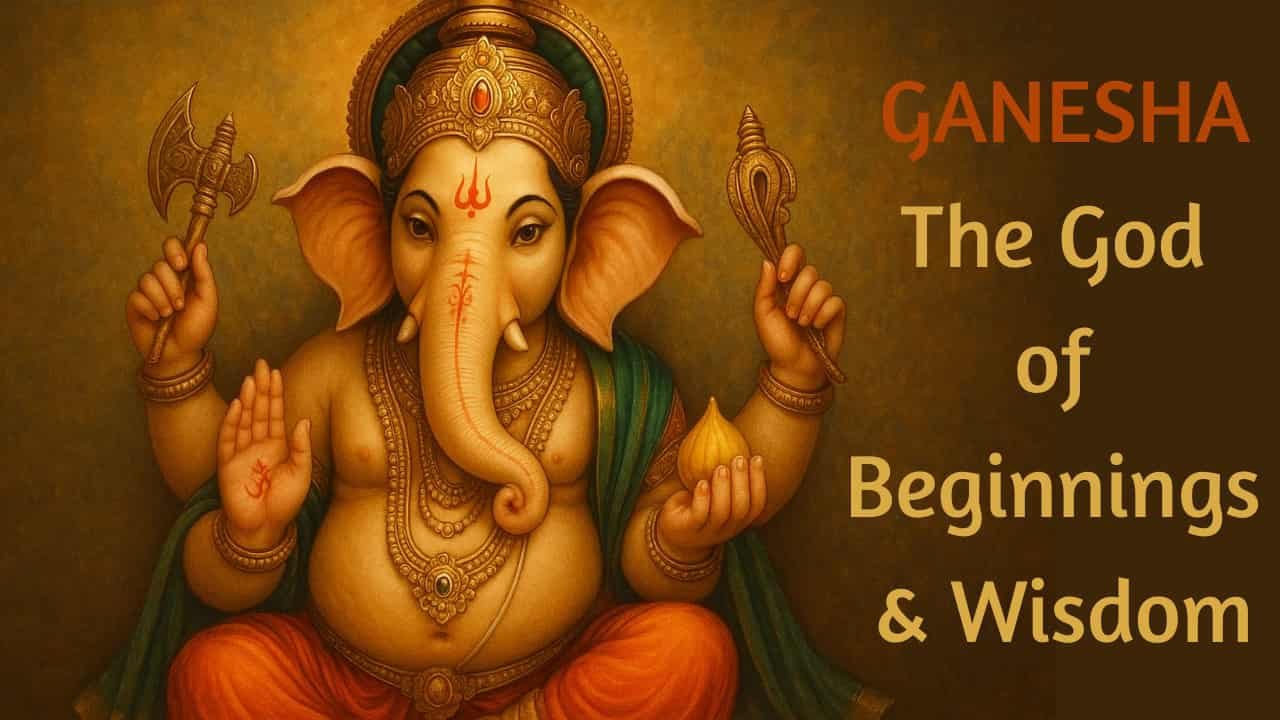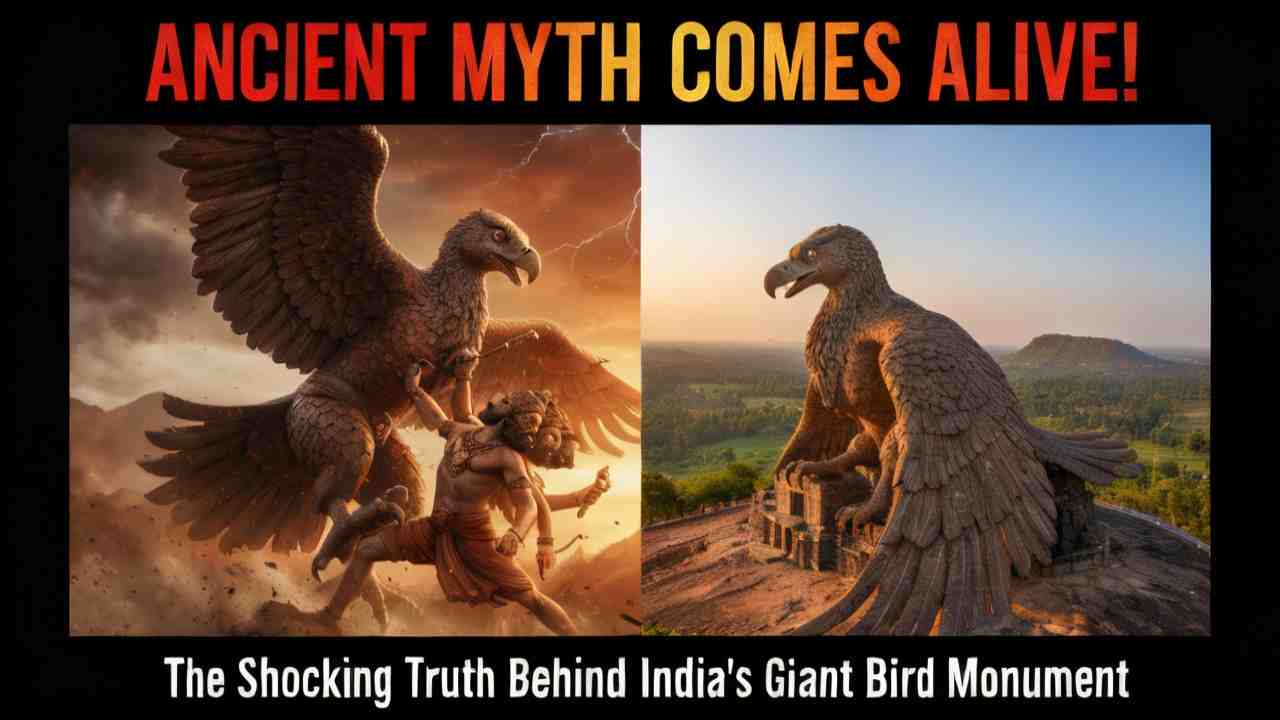
Among the countless tales in Hindu mythology, some shine not because of divine power, but because of courage born from righteousness. One such immortal story is that of Jatayu, a mighty vulture-like demi-god whose sacrifice became a symbol of loyalty and valor. When people ask, Who was Jatayu in Indian mythology? they uncover a legend that beautifully blends devotion, bravery, and dharma. His heroic act in the epic Ramayana remains one of the most poignant moments in the tale of Lord Rama and Sita.
Even today, the memory of Jatayu lives on through sacred sites like the Jatayu Earth Centre in Kerala and the Lepakshi Temple in Andhra Pradesh, where the bird’s fall and sacrifice are forever commemorated.
Who Was Jatayu in Indian Mythology?
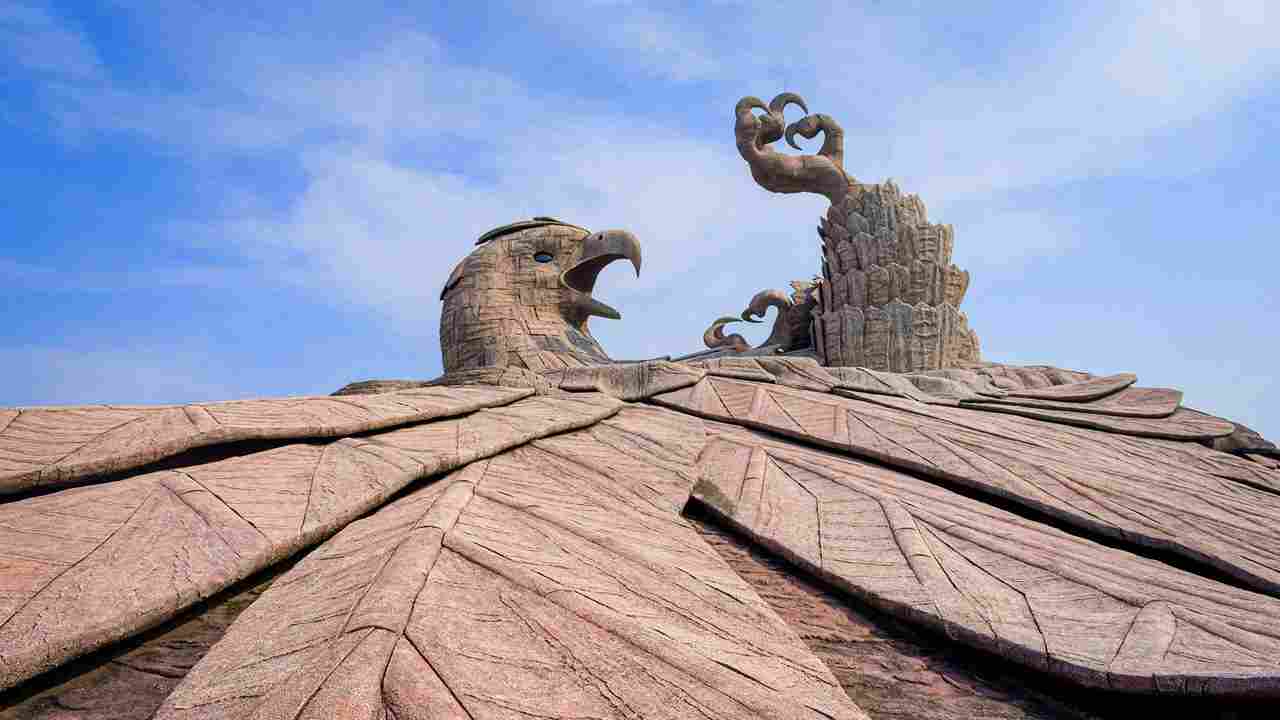
To answer the question, Who was Jatayu in Indian mythology? we must return to the pages of the Ramayana, the timeless epic composed by Sage Valmiki. Jatayu was a divine being with the form of a vulture. He was not an ordinary bird but a celestial creature born to serve a greater purpose. His father was Aruna, the charioteer of the Sun God, Surya, and his brother was Sampati, another great bird known for his wisdom.
Unlike ordinary vultures, Jatayu was blessed with divine strength, intelligence, and speech. His life was intertwined with the destiny of Lord Rama, as he had long been a close friend of King Dasaratha, Rama’s father. This connection would one day lead him to perform an act of unparalleled heroism.
The Noble Friend of Rama’s Father
Long before the exile of Rama, Jatayu and King Dasaratha shared a deep friendship based on respect and virtue. When Rama, Sita, and Lakshmana entered the forests during their 14-year exile, Jatayu recognized them immediately. The noble bird welcomed them warmly, offering his protection and company during their stay in the forest.
Jatayu’s presence symbolized the guardianship of nature over divine beings. Despite being old, he stood strong as a friend of righteousness. His bond with Dasaratha extended to his son Rama, showing how divine friendships can span generations and lifetimes.
The Abduction of Sita
The most dramatic and emotional part of the story of Who was Jatayu in Indian mythology unfolds during the abduction of Goddess Sita. When Ravana, the mighty demon king of Lanka, abducted Sita in his celestial chariot, the Pushpaka Vimana, her cries for help echoed through the forest.
Jatayu, who was resting nearby, heard her voice and rushed to her aid. Seeing the noble bird, Sita implored him to save her from the evil hands of Ravana. Jatayu, realizing the gravity of the moment, decided to confront the powerful demon despite his age and limited strength. This moment marked the beginning of one of the most courageous battles in Hindu mythology.
The Brave Battle in the Sky
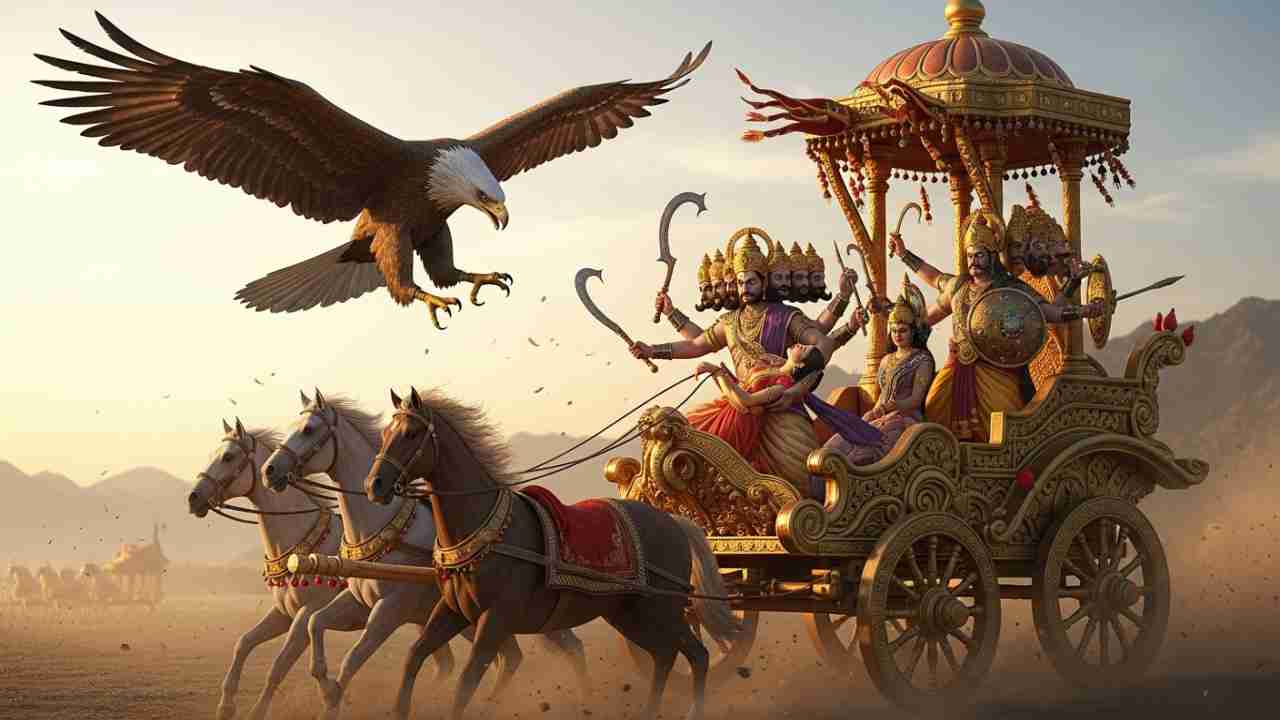
The story of Who was Jatayu in Indian mythology reaches its emotional peak during this battle. Jatayu took to the skies with immense speed and fury, blocking Ravana’s path. He declared that it was his sacred duty to stop any evil deed that violated dharma.
Jatayu struck Ravana’s chariot with his mighty wings, shattering parts of it and forcing the demon to engage in direct combat. Despite Ravana’s immense power and divine weapons, Jatayu fought valiantly, tearing off parts of the Pushpaka Vimana and wounding Ravana himself.
The bird used all his divine strength and even tried to rescue Sita by attacking Ravana with his sharp claws and beak. The battle raged fiercely across the skies and forests. However, as the fight continued, Jatayu’s old age began to weaken him. Ravana, enraged and desperate, took up his sword Chandrahasa and struck off Jatayu’s wings.
With his body mutilated and bleeding, Jatayu fell to the earth, but even in his final moments, he remained devoted to truth and righteousness.
The Fallen Hero
After Ravana fled southward with Sita, Jatayu lay on the ground, mortally wounded. Yet his soul refused to leave until he had fulfilled his final duty. When Lord Rama and Lakshmana, searching for Sita, came across the dying bird, they were heartbroken at the sight.
At first, Rama mistook Jatayu for a predator that had harmed Sita, but soon the bird spoke in a weak voice, revealing the truth. He told Rama everything. How Ravana had abducted Sita, the direction he took, and the details of the battle. His revelation gave Rama the crucial clue that led him south, ultimately to Lanka.
Deeply moved, Rama embraced Jatayu and performed his last rites with great honor, treating him like his own father. This act symbolized the Lord’s compassion and his recognition of true devotion. In Hindu belief, Jatayu attained moksha, or liberation, for his selfless act of dharma.
Symbolism of Jatayu’s Sacrifice
The story of Who was Jatayu in Indian mythology is more than just an account of a brave battle. It carries deep symbolic meaning. Jatayu represents the spirit of sacrifice and the fight for righteousness. Despite being a bird and aware of his limitations, he did not hesitate to face a mighty demon like Ravana.
In Hindu philosophy, Jatayu embodies the idea that standing up for truth and protecting virtue is the highest form of dharma. His selfless courage teaches that age, form, or strength are no barriers when one acts in defense of righteousness.
The fall of Jatayu is also a metaphor for the decline of virtue in the face of growing evil. Yet his memory reminds humanity that even in defeat, moral victory is eternal.
The Legacy of Jatayu in Indian Culture
Over centuries, the question Who was Jatayu in Indian mythology has inspired countless retellings in scriptures, art, and performance. In temple carvings, murals, and folk songs, Jatayu’s bravery is celebrated as a symbol of loyalty and truth.
In many regions of India, especially in the South, the spot where Jatayu is believed to have fallen is considered sacred. Devotees visit these places to pay homage to the noble bird who gave his life for the cause of dharma.
Jatayu Earth Centre, Kerala: A Monument to Courage
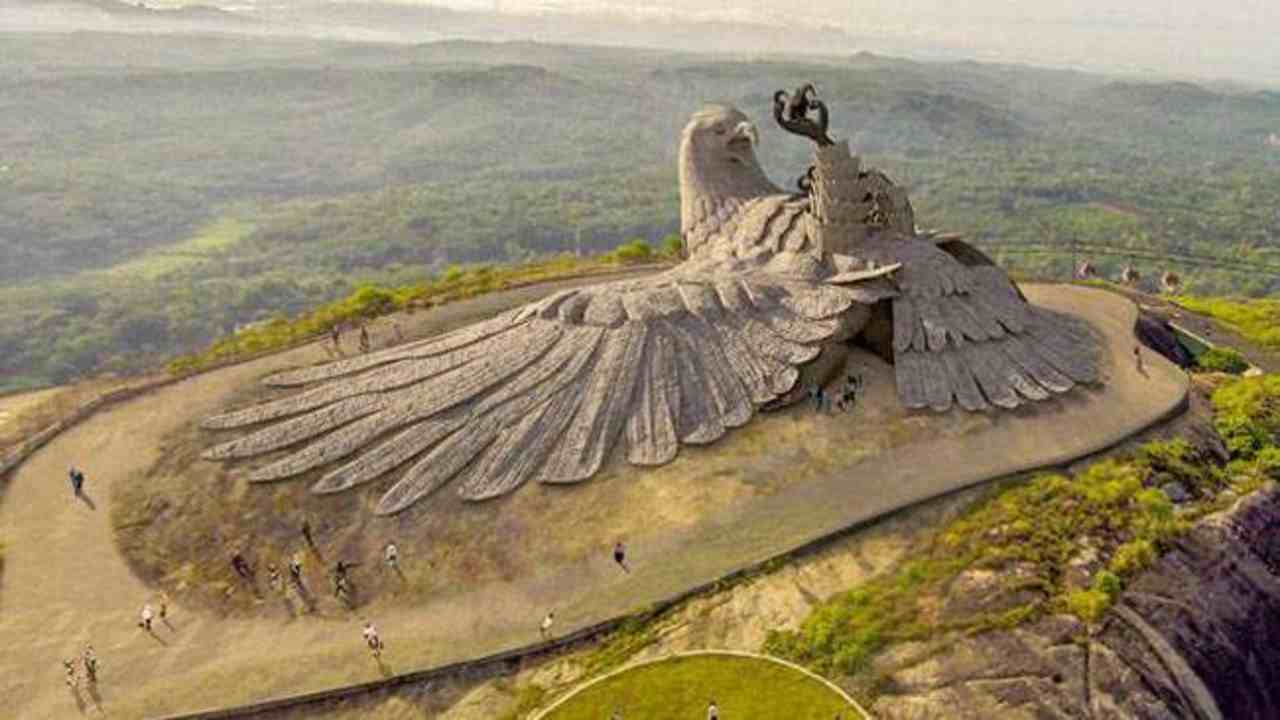
One of the most remarkable tributes to Jatayu’s legacy is the Jatayu Earth Centre in Kerala. Also known as Jatayu Nature Park, this massive tourist and cultural destination has been created to honor the story of the heroic bird.
Located at Chadayamangalam in Kerala, the Jatayu Earth Centre features the world’s largest bird sculpture, representing the fallen Jatayu. The sculpture is 200 feet long, 150 feet wide, and 70 feet high, making it a magnificent symbol of courage and devotion. The park is built on a hill where Jatayu is believed to have fallen after his battle with Ravana.
The Jatayu Earth Centre in Kerala is not just a tourist spot but a place of reflection. It teaches visitors about values like sacrifice, bravery, and protection of women. The site also includes adventure zones, a digital museum, and a 6D theater that narrates Jatayu’s story.
By creating this monument, Kerala has turned an ancient myth into a living reminder of moral strength and cultural pride.
The Lepakshi Temple and the Cry “Le Pakshi”
Another important location tied to Who was Jatayu in Indian mythology is the Lepakshi Temple in Andhra Pradesh. According to legend, when Jatayu fell mortally wounded, Lord Rama found him on this spot. Seeing his condition, Rama gently said the words “Le Pakshi,” which mean “Rise, O Bird” in Telugu.
This heartfelt command gave the place its name: Lepakshi. The temple built here later became a center of art and devotion. It is adorned with stunning Vijayanagara-style sculptures and murals that celebrate divine stories, including the tale of Jatayu.
Even today, visitors to Lepakshi Temple can feel the sacred energy of that moment, where divine compassion met heroic sacrifice.
Lessons from Jatayu’s Story
When we explore Who was Jatayu in Indian mythology, we also uncover timeless lessons that transcend religion and culture.
- Courage Beyond Strength:
Jatayu was old and frail, yet he did not hesitate to confront Ravana. True courage, the story tells us, comes not from power but from conviction. - Sacrifice for Dharma:
Jatayu risked his life to protect the innocent. His sacrifice reminds us that standing up for what is right is the highest duty of all beings. - Loyalty and Friendship:
His devotion to Dasaratha’s family shows that bonds formed through virtue are stronger than those of blood. - Respect for Nature:
Jatayu’s divine form as a bird also represents nature’s role in protecting dharma. His story teaches humanity to live in harmony with nature and honor its guardianship. - Compassion in Divinity:
Rama’s act of performing the final rites for Jatayu signifies that compassion knows no boundaries of species or form.
Jatayu in Art, Literature, and Popular Culture
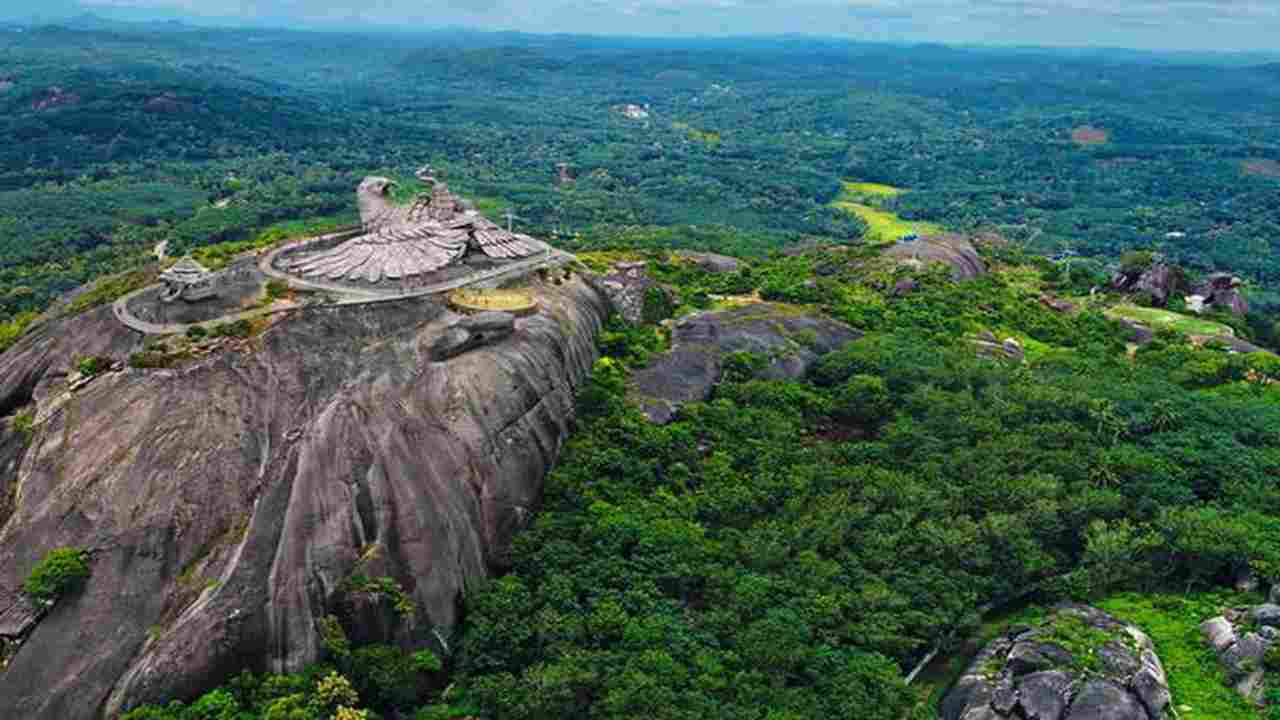
Over the centuries, the story of Who was Jatayu in Indian mythology has found expression in multiple forms of art. From temple carvings and dance performances to modern films and literature, his valor continues to inspire.
In classical dance dramas like Kathakali and Bharatanatyam, the episode of Jatayu’s battle with Ravana is performed with deep emotion and grandeur. Artists use it to convey themes of sacrifice and the eternal battle between good and evil.
Modern India also celebrates his memory through creative mediums. The Jatayu Earth Centre itself is a fusion of art, architecture, and technology. Bringing mythology to life for new generations.
The Spiritual Meaning of Jatayu’s Liberation
The final part of Who was Jatayu in Indian mythology lies not in his fall but in his liberation. According to belief, Jatayu’s soul attained moksha through Lord Rama’s blessings. This represents the spiritual truth that any act performed selflessly for dharma leads to ultimate freedom.
His story illustrates the essence of karma yoga, performing one’s duty without attachment to outcome. Jatayu’s fight was not for glory or recognition but for righteousness alone, and that selflessness granted him divine grace.
Jatayu as a Symbol of Modern Values
In today’s world, where moral values often seem to waver, revisiting the story of Who was Jatayu in Indian mythology offers fresh relevance. Jatayu stands as a symbol of protecting women, respecting virtue, and standing against injustice. These principles still deeply needed in modern society.
The creation of Jatayu Nature Park in Kerala beautifully aligns with these ideals. It merges mythology with environmental awareness, reminding people that heroism is not confined to the past but continues in every act of protection and compassion.
Final Thoughts: The Eternal Flight of Courage
So, Who was Jatayu in Indian mythology? He was more than just a divine bird. He was a guardian of dharma, a friend of the righteous, and a symbol of courage that transcends time. His fight with Ravana may have ended in physical defeat, but his moral victory echoes through the ages.
Through places like Jatayu Earth Centre in Kerala and Lepakshi Temple, his spirit continues to soar. Reminding humanity that courage, loyalty, and righteousness never truly fall.
Jatayu’s story is not just about mythology; it is about the eternal battle between good and evil within every heart. To remember him is to awaken the same divine spirit of sacrifice and virtue within ourselves.
FAQs
1. Who was Jatayu in Indian mythology?
Jatayu in Indian mythology was a divine vulture and a brave demigod from the Ramayana. He tried to rescue Goddess Sita from Ravana when she was abducted, symbolizing courage, loyalty, and sacrifice.
2. Where is Jatayu Earth’s Center located and why is it famous?
Jatayu Earth’s Center is located in Chadayamangalam, Kerala. It is famous for having the world’s largest bird sculpture, built to honor Jatayu’s heroic stand against Ravana. The park also promotes adventure tourism and eco-awareness.
3. What is the connection between Jatayu and Lord Rama?
Jatayu was a close friend of King Dasaratha, Lord Rama’s father. When Ravana abducted Sita, Jatayu fought to save her. Though mortally wounded, he informed Rama and Lakshmana about the direction in which Ravana had taken Sita.
4. What is the significance of Jatayu in the Ramayana?
In the Ramayana, Jatayu represents devotion and selfless duty. Despite being old and frail, he risked his life to uphold dharma by fighting Ravana. His sacrifice helped Lord Rama trace Sita’s whereabouts, making him one of the epic’s unsung heroes.
5. Are there any temples or sites dedicated to Jatayu in India?
Yes. Apart from Jatayu Earth’s Center in Kerala, another sacred site is the Lepakshi Temple in Andhra Pradesh, where it is believed that Jatayu fell after being wounded. The name “Lepakshi” means “Rise, Bird”, symbolizing Jatayu’s spirit and devotion.
